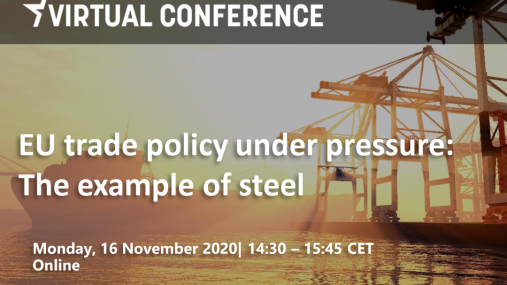
Downloads and links
Download files or visit links related to this content
News » EUROFER supported the 'EU trade policy under pressure: The example of steel' virtual conference
EUROFER supported the 'EU trade policy under pressure: The example of steel' virtual conference
Downloads and links
Recent updates
This event took place on 16 November.
The EU is at a crossroads, having suffered a sharp economic and social hit in recent months. The European Commission predicts a drop in EU GDP of 7.5 per cent in 2020. However, even in 2019, there were signs of underlying frailty in the EU economy.
Despite this, the EU has ambitious plans for its future, aiming to go green, digital and high-tech. But the global challenges remain the same: third countries taking advantage of the EU’s open borders and markets whilst refusing to share the same high ambition to decarbonise by 2050. EU trade policy is thus under pressure. It must evolve to meet rising competition abroad while giving the space for EU companies to
survive, thrive and go green.
This recession will have severe effects on global supply chains, especially if countries around the world seek to dump products on world markets to make up for a loss of local demand.
Join this EURACTIV Virtual Conference, supported by EUROFER, to discuss the crossroads we find ourselves at. If Europe is to thrive, how can EU trade be ready for a vastly different global future? How will industries, such as steel, fare? Questions to be discussed:
How can the multilateral trade framework be strengthened to ensure stability, predictability and a rules-based environment for fair and sustainable trade for EU companies?
16 November, 2020 - online.
14:30 – 14:35 Welcome
14:35 – 14:50 Panelists statements
14:50 – 15:40 Discussion and Q&A
15:40 – 15:45 Closing statements

Download files or visit links related to this content
A milestone occasion to quickly and effectively restore affordable electricity, to relaunch the
decarbonization and strengthen the international competitiveness of the European steel
industry.
Brussels, 02 December 2025 – Unchanged negative conditions – U.S. tariffs and trade disruptions, economic and geopolitical tensions, protracted weak demand and still high energy prices – continue to weigh on the European steel market. EUROFER’s latest Economic and Steel Market Outlook confirms for 2025 another recession in both apparent steel consumption (-0.2%, unchanged) and steel-using sectors (-0.5%, revised from -0.7%). A potential recovery is expected only in 2026 for the Steel Weighted Industrial Production index (SWIP) (+1.8%, stable) and for apparent steel consumption (+3%, slightly revised from +3.1%) – although consumption volumes would still remain well below pre-pandemic levels. Steel imports retained historically high shares (27%), while exports plummeted (-9%) in the first eight months of 2025.
Fourth quarter 2025 report. Data up to, and including, second quarter 2025